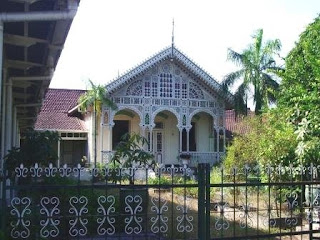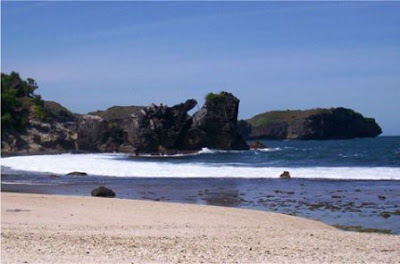Yogyakarta offers spots with natural nuances
Tuesday, December 9, 2008
If you are bored with visiting large cities and modernity, just come to Yogyakarta. In Kota Gede you can find a lot of tourist spots with a natural nuance and traditional Javanese elements.
A visitor can enjoy the rural nuances while interacting with local farmers, plow rice fields and plant or harvest rice. Or try your hand at making local crafts such as batik.
Besides the rural nuances, the food served is also traditional. Some of the dishes are based on recipes from Serat Centhini (an ancient Javanese book).
Natural and traditional nuances can be found in Sogan Village, a batik and furni-craft center with a restaurant in Rejodani hamlet, Sariharjo village, Sleman, Yogyakarta. Established in 2002 by Iffah M. Dewi, Sogan Village is located on 3,000 square meters of land and has a traditional Javanese atmosphere.
This atmosphere is apparent as soon as you enter Sogan Village. At the entrance there are two old buildings, a limasan (pyramidal) building, which was put up in 1854, and a joglo building dating back to 1858. Even the kitchen in Sogan Village is very old as it makes use of a building formerly used by the Dutch for drying tobacco.
The general manager of Sogan Village, Beny Tarigan, said that besides rural tourism, they also arrange tours such as trekking to Mount Merapi or white-water rafting on River Elo.
"We collaborate with professional teams with a good reputation in Yogyakarta," Beny said.
After enjoying nature-related tourism while savoring the panorama of Mount Merapi, a visitor can have a meal at Sogan Village restaurant, where 90 percent of the items on the menu are uniquely local dishes such as gudek (a dish made from young jackfruit), sambal krecek (baked buffalo hide with hot spicy sauce) and roast beef rib soup.
In Sogan Village, local people produce handicrafts, particularly hand-made batik. Visitors can take part in the making of these handicrafts. There is also a batik and handicrafts store here.
Not far from Sogan Village, about five kilometers to the southwest, is Kampung Kuntul (village of white herons). Located in Ketingan hamlet, Tirtoadi, Mlati, Sleman, Kampung Kuntul has thousands of white herons.
During the early wet season, thousands of white herons fly to Ketingan to mate. Every year, baby herons hatch and stay in Ketingan until they are old enough to fly. Their nests can be found in mlinjo trees that locals plant around their houses.
In the morning, visitors can enjoy the cool weather of the rural area while observing the activities of the white herons. They can see the white herons from a close distance and watch them feed their young.
Local people take good care of the herons and provide trees where the birds can make their nests. They also serve as a source of food. Every year over 3,000 visitors come to Ketingan to watch these birds.
There are homestays that rent rooms for Rp 75,000 per night, including traditional meals. At night, visitors can take in various traditional art performances.
Nature-related tours can be made not only to Sleman but also to Bantul. Here you can go to Tembi Cultural House on Jl. Parangtritis Km 8.4, which has the Tembi Resort Ndeso, which is a hotel with an ancient nuance.
Located in Tembi, Timbulharjo, Sewon, Bantul, Tembi Resort Ndeso has seven bungalows. They are all old like the limasan and joglo houses. Although they are hundreds of years old, these buildings are sturdy.
Aside from the panorama of nature, all the furnishings at Tembi Resort Ndeso are old. The hotel also has an open-air swimming pool with water always flowing into it. While swimming, a visitor can watch the activities of the local farmers.
The dishes served are traditional and taken from Serat Centhini, a book written in 1824. The menu items include buntil (dish made from papaya leaves), krecek, gudek, sambal jengot (hot spicy sauce made from grated young coconut).
The rates are also reasonable, considering the array of facilities offered. The seven bungalows are offered at rates ranging from Rp 386,100 to Rp 918,500 per night. One building is large enough for one family.
Collaborating with local artists and other galleries, Tembi Resort Ndeso offers traditional art performances on demand or they take visitors to watch art performances elsewhere.
If you walk farther south, to be exact to Kampung Giriloyo, you can also find a batik village. For hundreds of years, Giriloyo has been noted as a batik village. At present some 7,000 villagers are actively engaged in batik-making.
"You only have to pay Rp 45,000 per person and you can enjoy this handicraft-related tour. With a handicraftsman as a guide, you can see locals make batik and can be directly involved in batik-making," said Nur Achmadi, a resident of Giriloyo.
Nur Achmadi said the Rp 45,000 includes lunch and a snack, which are all traditional. You will be served tumpengan (conical rice plus vegetables) to be eaten together or ingkkung (free-range chicken cooked whole in spices).
Two kilometers to the southwest of Giriloyo, there is a place for agriculture-related tourism, namely in Kebon Agung, Omogiri, Bantul. In Kebon Agung, a visitor can plow a rice field or harvest rice. He can also go canoeing as there is a big irrigation dam there.
As a village for agriculture-related tourism, there is also a farmer's museum where various farming implements are displayed. Some of them are hundreds of years old such as a 1921 jodang (fruit tray used in a harvest ritual), a 1883 gentong (large vessel for storing unhusked rice), a luku (plow) made in 1927, a hoe, a sickle, dandang (copper vessel for steaming rice) and kukusan (a cone-shaped bamboo basket for steaming rice). Also on display are cooking utensils such as anglo (charcoal brazier), dandang, ceting bambu (small bamboo rice container) and farmer's equipment such as lesung (mortar) and pipisan (herbal medicine mixer).
In the late afternoon, a visitor can proceed to Parangtritis beach to see the sunset. Besides enjoying the panorama of the sea, a visitor can also enjoy the sight of a wide expanse of sand dune east of Parangtritis beach.
source : www.thejakartapost.com










































.jpg)







